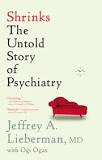 Shrinks: The Untold Story of Psychiatry will be of interest to you if you are a
psychiatrist and psychoanalyst, like I am, or if you’ve ever been in
psychotherapy. The author, Jeffrey Lieberman, M.D., is the Chair of the
Department of Psychiatry at Columbia, and he is a recent past president of the
American Psychiatric Association. He was the president of the APA when it
released its most recent “Bible” of psychiatric diagnoses, the DSM-5, and he is particularly known for
his work with schizophrenics. Dr. Lieberman provided a cogent history of
psychiatric diagnosis in the U.S. and Europe.
Shrinks: The Untold Story of Psychiatry will be of interest to you if you are a
psychiatrist and psychoanalyst, like I am, or if you’ve ever been in
psychotherapy. The author, Jeffrey Lieberman, M.D., is the Chair of the
Department of Psychiatry at Columbia, and he is a recent past president of the
American Psychiatric Association. He was the president of the APA when it
released its most recent “Bible” of psychiatric diagnoses, the DSM-5, and he is particularly known for
his work with schizophrenics. Dr. Lieberman provided a cogent history of
psychiatric diagnosis in the U.S. and Europe.
Lieberman concluded
with a comment about the value of “pluralism” in psychiatry today, meaning that
psychiatrists who operate at the respective poles of biology on the one hand
and psychoanalysis on the other, both have something to offer those seeking
clinical care today. However, much of his book was an assault on psychoanalysis
being an unproven and unscientific theory. In my opinion, some of the attack on
analysis was well deserved. Freud predicted that biologic causes and cures
would eventually be found for mental illness, but at the time he published The Interpretation of Dreams in 1900,
there were no treatments available for the more serious psychiatric diagnoses
such as schizophrenia and manic-depressive (bipolar) illness. Such people were
simply warehoused in massive state hospitals with no hope of recovery. Some
psychiatrists attempted to treat such people with psychoanalysis, and others
tried barbaric forms of therapy such as insulin shock, lobotomy, and
electroconvulsive shock therapy. Only the later was proven to have some
efficacy in some patients. It was not until the 1940s that serendipity led to
the discovery of the first effective psychotropic medications, and the
evolution of such medications led to the reduction in the huge inpatient
populations during the 1950s and 1960s. Meanwhile, the DSM-I was finally published in 1950 as an attempt to have some
reliability among the diagnostic language used by psychiatrists. By then, the
analysts were in full control of the APA, and it seems most had forgotten
Freud’s prediction about finding the biologic underpinnings of the serious
illnesses they were trying to treat. It took some decades before the pendulum
of power in the APA swung to the biologic side, where it stands at the moment.
There was a time
when analysts and biologic psychiatrists could not communicate about their
ideas. Analysts saw the others as being barbaric and biologic (or
brain-focused) psychiatrists saw analysts as proponents of an unproven and
scientifically ungrounded theory. It was not until the DSM-III in 1980 that the
brain-focused ones finally expunged analytic theory from the diagnostic
language. As a psychiatrist, I found Lieberman’s review of the evolution of our
diagnostic language to be fascinating and well-presented.
At the present
time, it is clear that psychoanalysis should never have been used to treat the
most serious and psychotic illnesses. Certainly analysts brought on some of the
eventual enmity they faced by overselling the value of this discipline. But it
does remain a treatment of choice for patients with greater ego functioning
(and I use the word “ego” in an analytic sense, not as it is used in common day
language). Freud did not get everything wrong, and his contributions such as
the unconscious mind and transference are critically important to understanding
and treating less severely ill patients. However, even when I graduated from a
psychoanalytic institute in 1990, some of the senior analysts still bragged
that they had never prescribed a single medication to any of their patients.
They believed that by prescribing medication, the analyst would be leaving unconscious
resistances hidden and untreated. Clearly, those analysts caused harm by eschewing
the use of medications that had been proven to have efficacy in depression,
mania, and schizophrenia. It was my era of analysts that developed the idea
that psychotropic medication and psychoanalysis/psychotherapy were synergistic
when used in the right patients, not mutually incompatible. That was a battle
that was not easily won.
Lieberman wrote,
“The brain is an interface between the ethereal and the organic, where the
feelings and memories composing the ineffable fabric of experience are
transmuted into molecular biochemistry. Mental illness is a medical condition –
but it’s also an existential condition. Within this peculiar duality lies all
the historic tumult and future promise of my profession – as well as our
species’ consuming fascination with human behavior and mental illness.”
Lieberman concluded his book with a remark about an important remaining problem
that is faced by psychiatrists and their patients: “Today the single greatest
hindrance to treatment is not any gap in scientific knowledge or shortcoming in
medical capability but the social stigma. This stigma, unfortunately, has been
sustained by the legacy of psychiatry’s historic failures and it enduring
reputation – long longer justified – as the unwanted stepchild of medicine.”
Well said.
No comments:
Post a Comment